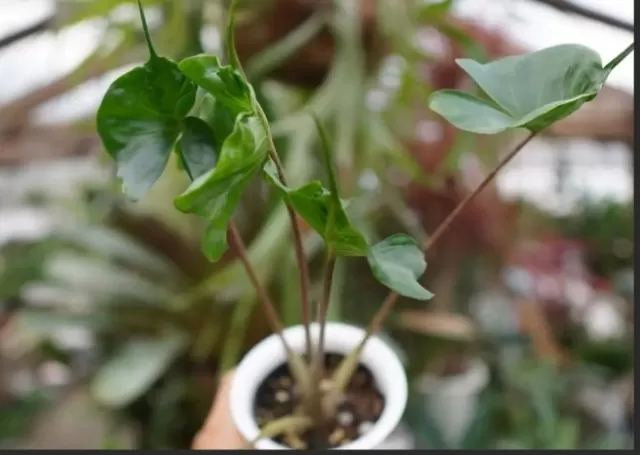The Priciest Houseplants That Find Their Way Into Homes. The classification of collectors who spend significant amounts of money on single houseplants can be subjective and vary depending on individual perspectives.
Some might consider them innovative investors, while others might view their actions as extravagant or eccentric.Critics might argue that the money spent on such high-priced plants could be used for more practical purposes or charitable contributions. They might view the obsession with rare houseplants as a form of conspicuous consumption or an indication of misplaced priorities.
Ultimately, whether collectors who invest heavily in houseplants are seen as innovative investors or eccentric spenders can depend on various factors, including the motivation behind their purchases, their financial means, and the value they place on unique and rare plants. The perception of their actions may differ significantly from person to person.
Growing Green in Greenery: The Rise of Rare Aroid Houseplants as Investment Gems

Amidst the confinement of the pandemic, an unexpected trend has emerged in the world of gardening – the flourishing interest in rare aroid houseplants.
With their alluring variegated, elongated, or dark-hued leaves, these botanical marvels have captured the hearts of gardeners and collectors alike, with some specimens commanding astonishing prices, akin to the mythical “unicorns. “.
Dubbed “unicorns” due to their scarcity and the horn-like spadices of tiny flowers they bear, these aroids have become the newest fascination for passionate plant enthusiasts.
In a time where many have found solace in indoor gardening, these unique foliage plants have taken center stage, attracting investments from those seeking both beauty and potential financial gain.
Indeed, for some, nurturing these prized aroids has evolved into an intriguing form of green investment, where the term “growing your portfolio” takes on a literal meaning.
As the demand for rare aroids rises, their market value has soared, creating opportunities for savvy gardeners to turn their green thumbs into profitable ventures.
However, as with any investment, there are risks to consider.
While the allure of variegated aroids may be undeniable, there lies a potential pitfall: the dreaded reversion. Variegation, a result of genetic mutations, can sometimes be unstable, leading the coveted multi-colored leaves to revert back to a less valuable, all-green appearance.
Such an unexpected transformation can cause collectors to experience a considerable loss of “greenbacks” – the currency invested in acquiring these prized plants.
Nevertheless, the allure of rare aroids remains strong, and passionate enthusiasts continue to explore this fascinating niche.
As the gardening community embraces these captivating plants, it becomes evident that investing green in greenery not only enhances the aesthetics of living spaces but also presents a thrilling opportunity to grow one’s passion, knowledge, and, potentially, their financial worth.
In this ever-evolving world of indoor gardening, the allure of rare aroid houseplants persists, inviting enthusiasts to tread carefully as they embark on a journey that combines the beauty of nature with the potential for financial growth.
As the trend of green investments continues to bloom, it remains to be seen how this unique form of portfolio diversification will shape the future of both gardening and finance.
Monstera adansonii variegata: The Astonishing Price of Nature\’s Masterpiece
In the world of plant enthusiasts, few species can command prices as monstrous as the Monstera adansonii variegata.
Recently, a striking example of this plant fetched a staggering $38,000 on the online marketplace eBay. While the typical all-green Monstera deliciosa may not boast such eye-watering price tags, it is the rare varieties adorned with unique attributes that draw such astronomical sums.
These mesmerizing specimens display intricate patterns of holes, known as “fenestration,” and are further adorned with elegant splashes of white variegation.
It is this combination of distinct features that sets the Monstera adansonii variegata apart, making it one of the most sought-after plants in the gardening world.
For plant enthusiasts, getting their hands on this masterpiece can be quite a challenge, and its scarcity drives prices to astonishing heights.
A single rooted cutting of the Swiss cheese vine with such exceptional characteristics can fetch prices in the hundreds, while more established plants can command prices in the thousands.
The name of this captivating plant, Monstera adansonii variegata, pays homage to the 18th-century French botanist Michel Adanson, who lived a life of poverty during his time.
It is fascinating to imagine how astounded Adanson would be if he could witness the incredible value attached to the plant that bears his name today.
As the allure of these rare monsteras continues to captivate the gardening community, it reminds us of the profound impact that nature can have on our lives – not only in terms of aesthetics but also in terms of the value we place on its unique creations.
The pursuit of the Monstera adansonii variegata symbolizes the enduring fascination with the natural world, as enthusiasts and collectors alike seek to embrace the beauty and rarity that these plants offer.
In a world where prices of commodities constantly fluctuate, the Monstera adansonii variegata stands as a testament to the timeless allure of nature and its ability to captivate hearts and wallets alike.
As this magnificent plant continues to captivate the imagination of plant lovers worldwide, it reinforces the notion that sometimes, the true treasures of our world are found in the most unexpected and extraordinary places.
Philodendron joepii: Unveiling the Enigmatic Ear-Leaf Philodendron

In the realm of philodendron plants, the Philodendron joepii stands apart, defying the usual heart-shaped leaf pattern that characterizes its botanical relatives.
Instead, each leaf of this peculiar species appears to possess distinctive features resembling ears at the top, a narrow neck, and a broad tongue-like structure. The unique appearance of this plant has sparked intrigue and fascination among horticulturists and collectors alike.
The origin of its name can be traced back to the Dutch naturalist who first stumbled upon this extraordinary species.
In 1991, during an exploration in the lush landscapes of French Guiana, the plant was discovered growing on an anthill, and thus it was aptly named after its discoverer – Philodendron joepii.
Interestingly, the exact origins of this captivating philodendron remain shrouded in mystery.
Botanists speculate that it could potentially be a hybrid resulting from the crossbreeding of two known species. Despite its enigmatic parentage, what remains undeniable is the plant’s novelty and rarity.
Such a recent discovery, the Philodendron joepii is yet to find its place on the esteemed Plant List, a comprehensive database of plant species.
This underscores the exclusivity and limited availability of this remarkable plant.
Given its unique attributes and scarcity, the Philodendron joepii commands a high price in the market.
Enthusiasts and collectors who wish to add this botanical gem to their collection might find themselves spending a substantial sum, with a single stem cutting demanding prices exceeding $2,000.
As with many rare and elusive species, the allure of the Philodendron joepii lies not only in its striking appearance but also in the thrill of owning a piece of botanical history.
Its discovery and subsequent rise to horticultural fame remind us of the never-ending wonders that the natural world has to offer, with each unique plant holding the potential to captivate our hearts and ignite our passion for the beauty of nature. As plant enthusiasts continue to seek out and celebrate these botanical treasures, the Philodendron joepii stands tall as an extraordinary testament to the diversity and intrigue of the plant kingdom.
Monstera obliqua \’Peru\’: Embracing Elegance in Sparse Foliage
For those seeking an unconventional and visually striking addition to their plant collection, the Monstera obliqua ‘Peru’ presents a captivating option.
Unlike the lush and dense foliage seen in typical houseplants, this unique cultivar boasts leaves that are surprisingly sparse, resembling the remnants of a leaf after a hearty feast by giant, voracious insects.
The appeal of the ‘Peru’ variety lies in its striking variegation and extensive fenestration, which adds an air of mystery and elegance to any space it inhabits.
However, acquiring this botanical marvel comes at a cost, with prices ranging from around $200 for simple stems with nodes to a substantial $7,000 for a potted plantlet.
Prospective buyers should be aware of the specific care requirements for this particular cultivar.
Monstera obliqua ‘Peru’ is not known for its rapid growth, so patience is necessary as it gradually climbs and develops. Additionally, its leaves are delicate and paper-thin, necessitating gentle handling to preserve their exquisite appearance.
To thrive, this plant requires a high level of humidity, replicating its native tropical environment.
It’s important to note that Monstera obliqua ‘Peru’ should not be confused with Monstera karstenianum ‘Peru,’ which offers a completely different foliage experience.
The latter variety features leathery and puckered leaves, lacking the characteristic fenestration found in the former. While both cultivars have their unique charm, the ‘Peru’ version stands out for its captivating hole-filled leaves that exude an air of sophistication and intrigue.
As plant enthusiasts continue to explore the vast array of botanical wonders, the Monstera obliqua ‘Peru’ stands as a testament to the diversity and artistry of nature.
Its sparse yet striking foliage reminds us that beauty can be found in the most unexpected forms, offering a fresh perspective on the world of indoor gardening and plant appreciation.
Monstera deliciosa albo variegata: The Enchanting Splendor of the White-Splashed Big Cheese

For those who appreciate the classic charm of the traditional Swiss cheese plant, Monstera deliciosa, but seek a touch of uniqueness, the Monstera deliciosa albo variegata is an exquisite choice.
This captivating plant showcases the iconic splits in its leaves, akin to its more typical counterpart, but with an added touch of splendor – elegant white-splashed variegation that sets it apart.
Sometimes referred to as “borsigiana,” a synonym for the deliciosa species, the Monstera deliciosa albo variegata has gained a reputation as the “big cheese” among plant enthusiasts.
However, its allure and exclusivity come at a price, with larger, mature specimens fetching prices upwards of $8,000.
As this magnificent plant matures, it unfolds its grandeur, producing leaves that can reach an impressive 18 inches in width.
Much like the aging process of real cheese, the Monstera deliciosa albo variegata requires time and patience to fully develop and reveal its full splendor.
Embracing the Monstera deliciosa albo variegata introduces a fresh twist to the classic elegance of the Swiss cheese plant.
The mesmerizing play of white variegation against the deep green leaves creates an enchanting spectacle, making it a captivating centerpiece in any botanical collection.
As plant enthusiasts continue to seek out distinctive and extraordinary varieties, the Monstera deliciosa albo variegata stands tall as a testament to the endless possibilities of nature’s creativity.
Its harmonious blend of tradition and novelty encapsulates the ever-evolving world of indoor gardening, reminding us that beauty can be found in the subtlest of details and that patience is often rewarded with a spectacle of splendor.
*The information is for reference only.